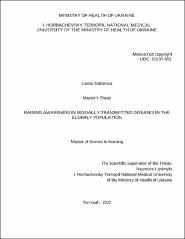| dc.description.abstract | Sexual activity is an important part of later life, frequently associated with better cardiovascular health, greater self-esteem, and higher life enjoyment levels. The population of people aged 50 and older in the United States is expected to grow substantially due to factors such as increased lifespan, decreased fertility, and the aging of baby boomers An increase in sexual activity among middle aged adults and the elderly resulted in a dramatically increased prevalence of sexually transmitted diseases (STDs) such as HIV/AIDS, syphilis, gonorrhea, trichomoniasis, and chlamydia.
Concerning STDs in patients over age 50, the literature focuses mainly on HIV/AIDS, with very little published on other STDs. Also, we took date from Center for Disease Control and Prevention and national AARP survey(2010).We find out that, lack of awareness may span from prevention and treatment programs primarily targeting young adults. Consequently, this may cause the older population to believe they are not affected. Social marketing campaigns targeting older adults are necessary to encourage safer sex and raise awareness with messages that are age-appropriate and culturally sensitive. The CDC recommends routine HIV screening for persons up to age 64. Persons over 64 should be counseled to receive HIV testing if they have risk factors. Also, intervention strategies to help older women negotiate safer sex are especially important. There is a great need for all health care providers to be educated about addressing sexual health and risk for STDs among older adults. A collaborative effort involving families, health care providers, policy-makers, and community leaders at all levels is required. Nurses can advocate for the development and implementation of educational initiatives to increase the awareness of STDs among older adults. This education should be initiated in nursing school and continue as part of required continuing education throughout the span of the nurse’s practice. Important issues to address related to sexuality in older adults include safe sex practices, physical and emotional comfort level of sexual activity, and how a patient’s medical conditions and/or medications are affecting his or her sexual desire and/or performance.
Raising Awareness in Sexually Transmitted Diseases in the Elderly Population
Introduction Sexual activity is an important part of later life, frequently associated with better cardiovascular health, greater self-esteem, and higher life enjoyment levels. The population of people aged 50 and older in the United States is expected to grow substantially due to factors such as increased lifespan, decreased fertility, and the aging of baby boomers (CDC, 2003). As a result, there is a significant need for healthcare services that address chronic diseases as well as preventative services for this demographic. One area that needs particular attention is sexual health. An increase in sexual activity among middle aged adults and the elderly resulted in a dramatically increased prevalence of sexually transmitted diseases (STDs) such as HIV/AIDS, syphilis, gonorrhea, trichomoniasis, and chlamydia.
Sexuality in Elderly
According to the 2010 national AARP survey, that was testing adults of age 45 and older attitudes regarding sexuality, people in this age group are having sex and sexuality remains an essential element of their lives (AARP, 2010). Moreover, the survey shows that “just under 3 in 10 of those surveyed (28%) report they had sexual intercourse once a week or more often and 40 percent report having intercourse at least once a month” (AARP, 2010). These results show that elderly continue to be sexually active and sexuality is an important element of their lives. In addition, the results of the AARP survey show elderly have more open attitudes toward sex and sex is critical to a good relationship. The elderly population remains sexually active and many factors contribute to that trend including the increasing availability of drugs for erectile dysfunction and treatments for vaginal dryness. Moreover, older adults are often searching for companionship due to the divorce and/or loss of the spouse (Maes, Louis, 2003), and many of these new relationships become sexual in nature (Savasta, 2004).
Sexually Transmitted Diseases
Sexually transmitted diseases (STDs) are infectious diseases acquired through sexual activity with an infected person. Other STDs, such as hepatitis B and HIV viruses may also be transmitted by means of blood (Talashek, 1990). Many STDs have no physical signs and symptoms, leaving the patient unaware of the infection without proper diagnostic testing. It is important to note that older adults who are sexually active are at risk for acquiring a new STD, while others may be carrying an untreated infection from the past.
Physical changes in older adults contribute to the higher risk of acquiring sexually transmitted infection. Postmenopausal women’ vaginal tissues thin and natural lubrication decreases, increasing the risk of micro tears and abrasion during intercourse allowing microorganisms a greater number of sites for entry (Boudes, 1989). Moreover, the immune system naturally declines with age, which can also increase the risk of sexually transmitted diseases (Scura, 1990). Older people are also less likely to use condoms, as they are past reproductive years and may not be concerned about unwanted pregnancy and are often unaware of STDs risk | uk |

